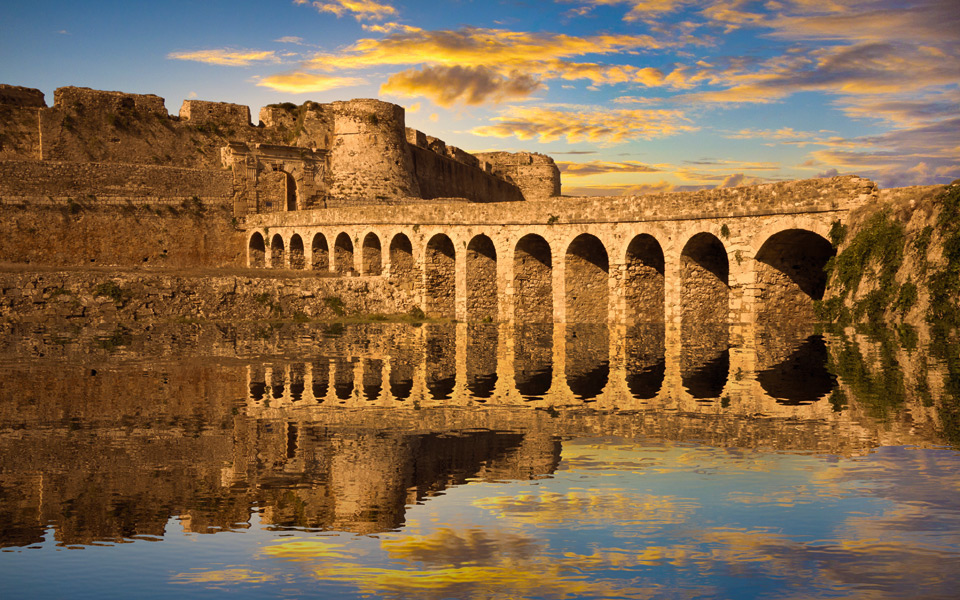
Greek Caribbean
Best known for Simos beach, with golden sand dunes, tamarisk trees and bountiful fish, Elafonisos was, until 2,000 years ago, a peninsula and home to a breed of small red deer (elafi in Greek). A mighty earthquake, however, broke it off from the Peloponnese and turned it into the region’s only inhabited island. Elafonisos is a place of outstanding natural beauty, protected under the Natura 2000 network, and a paradise for water-sports enthusiasts. Just off the coat lies the sunken city of Pavlopetri dating to the 3rd millennium BC, which some say inspired the Atlantis myth.

Rooting Around
What may be a dream for most is just another day at work for Sotiris Lymberopoulos, an economist who abandoned office life to return to his village, Raches in Kyparissia, to become a modern-day forager. Lymberopoulos supplies gourmet restaurants with hard-to-find wild greens, truffles, roots and fruits through his successful start-up, Radiki, a leading proponent of the back-to-roots food movement and a purveyor of freshly-picked ingredients, unprocessed and with a minimal environmental footprint – proof that the Peloponnese offers plenty of opportunity to think outside the box.

(L) Southern Star (R) BABy ALPS
(L) “When you pass Malea, forget your home,” wrote the ancient geographer and historian Strabo when describing the important yet treacherous crossing at the southernmost point of mainland Greece. Off the coast of Laconia, it is lashed by unpredictable winds and frequent storms that swallowed ships or dashed them on the rocks. The 15-meter stone lighthouse built in 1883 to cast its life-saving light at a distance of up to 40 nautical miles, was beautifully restored a few years ago and stands today as a landmark for trekkers taking on the 8.5k trail from the lovely village of Velanidia.
(R) On the highest peaks of Mount Taygetus, the snow melts only for short spells. The biggest range in the Peloponnese, it is named after the nymph Taygete, daughter of the Titan Atlas, and is also known locally as “the five-fingered” (Pentadaktylos) because its five peaks resemble the knuckles of a fist. It spans 115 kilometers from Megalopoli in the north to Cape Tainaro in the south. With its highest peak rising 2,407 meters above sea level, four separate climatic zones, innumerable gorges, ravines and caves, a wealth of flora and fauna, along with dozens of traditional villages and hamlets, Taygetus is an endless source of tales and legends, as well as thrills for mountain sport aficionados.

Wildilife Haven
Nature has been bountiful with the beauty and biodiversity it has bestowed on the 2,200 hectares that comprise the Kotychi-Strofilia Wetlands on the northwestern tip of the Peloponnese, just a one-hour drive from Patras. A forest of pine, cedar and oak gives way to undulating dunes that stretch to the lagoons of Prokopos and Kotychi and the Ionian Sea. Its permanent residents include turtles and tortoises, martens, hedgehogs, otters, foxes, kingfishers, owls and coots, as well as eels, sea bass and grey mullet. It is also a haven to migratory birds such as herons, swallows, hawks, turtle doves, ibises and hoopoes, among other species. Binoculars are a must.

Stormy Past
An enthralling example of a fortified city and one of the most emblematic in Greece, Methoni Castle was built in the early 13th century by the Venetians and became a key transit point for all ships sailing in the Eastern Mediterranean. It grew to become a booming city until its bloody conquest by the Ottomans in the late 15th century. For centuries a strategic battleground, the castle stands defiantly on a rocky promontory, protected by the sea on three sides. Locals say that the winter winds carry the cries of those who died trying to defend or storm it.








